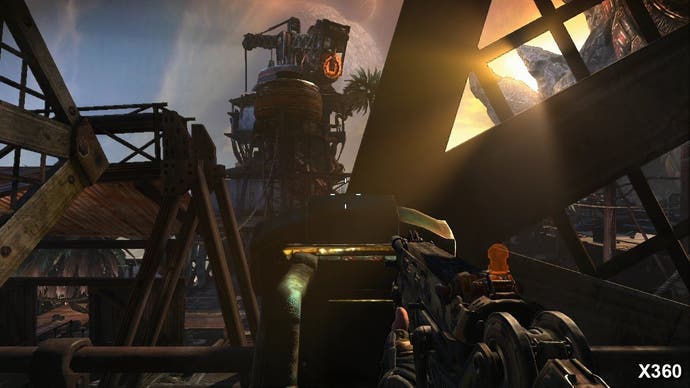Face-Off: Bulletstorm
Lead better?
As we saw most recently in Ninja Theory's Enslaved: Odyssey to the West and last year's Batman: Arkham Asylum, Unreal Engine 3 seems to favour the Xbox 360 from a performance perspective, particularly in large, expansive areas, perhaps suggesting some kind of a bottleneck on processing complex geometry.
Bulletstorm allows us the opportunity to judge UE3 performance in what you would think would be the best possible scenario - with the tech being handled by Epic itself, or at least by a satellite studio exceptionally au fait with the engine (People Can Fly also handled the PC version of the original Gears of War prior to its acquisition by Epic).
As per the norm, we put the game through two different performance tests. In the first we do our best to feed the analysis software with as close to like-for-like video as we can. In this way, the hope is to better understand how each implementation of Unreal Engine 3 copes when under the exact same load.
The results are inconclusive in this case because the PS3 and 360 versions of UE3 are being configured in different ways during the cut-scenes. People Can Fly has enabled v-sync on the engine-driven cinematics on Xbox 360, but allows screen-tear on the PlayStation 3 cut-scenes. Quite why these different rendering configurations have been used is a bit of a mystery.
Basically we aren't comparing like-for-like here then, but what we are seeing is something quite intriguing - the impact v-sync makes when the engine drops frames. You can see that while PS3 tears significantly, the overall frame-rate remains much higher than it does on Xbox 360.
In-game, we see the restoration of parity in the way that frames are output. As with most UE3 titles, the console versions of Bulletstorm are capped at 30 frames per second and when the game drops frames, it also drops v-sync. This introduces screen-tear, but keeps screen refresh and response from the controller as fast as possible.
In this second test, we extract clips from the same general areas of gameplay. While we don't get to see the games running in completely like-for-like situations, it does give us some idea of the performance level of both versions across the run of play - something which is arguably a lot more important.
To all intents and purposes it looks like business as usual for a demanding Unreal Engine 3 title - both versions can tear and drop frames, but it's the Xbox 360 version that generally seems to be the better performer, especially so in those large, open areas.
Moving on to the PC game and it's clear that there's a pretty colossal visual leap over what we see on console. Geometry levels appear to be much the same, but everything else can be turned up to 11. The most impactful change is to the quality of the textures, but just about all of the key effects - including the light shafts - are significantly upgraded over what we see on the Xbox 360 version of the game.
Indeed, even in the most basic like-for-like shots we see a generally more smoother, richer look to the game, suggesting that perhaps Epic is operating with a higher precision framebuffer format than they are in the console versions.
Let's re-run our initial head-to-head comparison, this time pitting the Xbox 360 version against the PC game. If you'd rather compare the PS3 and PC versions of Bulletstorm, we've got that covered too.
The PC version also one-ups the console games by offering support for up to 8x anti-aliasing without recourse to the GPU control panel - something of a rarity in PC UE3 titles, and something that definitely helps in refining the overall look of the game. Just about all the major effects appear to have been upgraded to some extent; particles appear to be more voluminous on PC, motion blur operates with more samples, and the light shaft effect has a significantly higher precision compared to its Xbox 360 counterpart.
Again we get the impression that this tech does have quite a significant impact on the overall look of the outdoor scenes. Let's revisit the previous comparison screenshots we ran illustrating the subtle and not-so-subtle effects of this tech, and this time put the PC version up against the 360 game.




For games enthusiasts, one of the most attractive features of PC gaming is the ability to spec out your own rig, enabling users to power past the limitations of the five-year-old consoles with new and more powerful tech. As a fast action arcade shooter, Bulletstorm benefits significantly from being run at 60 frames per second as opposed to the 30FPS seen in the Xbox 360 and PS3 versions, as we'll discuss later. To get this level of performance, we'd recommend a quad-core CPU and something along the lines of an NVIDIA GTX460 to ensure top-level performance, but even lower end GPUs should still easily outstrip console quality and frame-rate.















